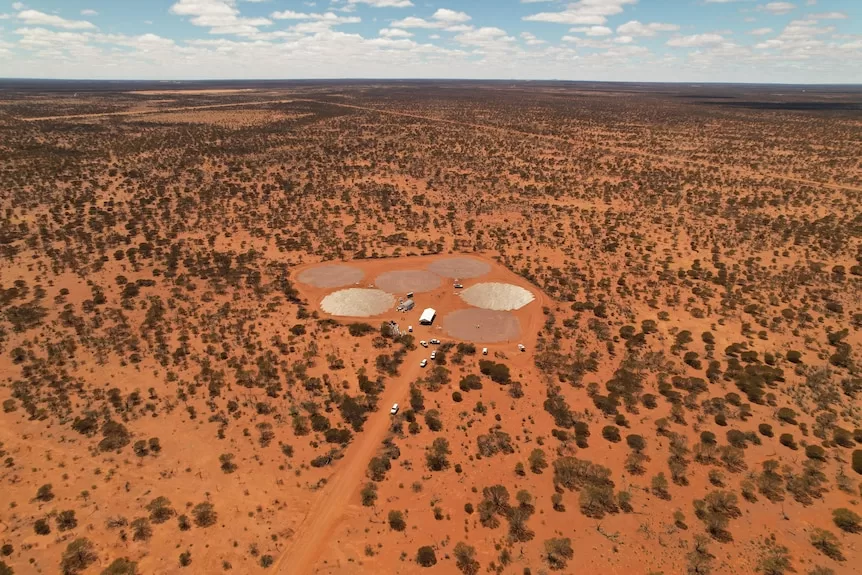- In short: The first antenna has been installed in Western Australia for what will be the world’s largest radio telescope.
- Scientists say the facility will be a “time machine”, offering insights into the dawn of the universe never seen before.
- What’s next? There are more than 130,000 antennas still to be installed, and the project is scheduled for completion in 2028.
As construction ramps up on the world’s largest radio telescope in outback Western Australia, the Indigenous community says the $3 billion project has brought hope for more opportunities in the desert region.
The first of 131,072 antennas have been installed on Wajarri Yamaji country in the Murchison region, as part of the Square Kilometre Array telescope, known as SKA-Low.
It is one of two telescopes, together with SKA-Mid in South Africa, being built by a global radio astronomy organisation, the Square Kilometre Array Observatory (SKAO), in what’s described as the world’s largest science project.
Those behind the project said it would provide an unparalleled view of the universe, allowing scientists to explore the first billion years after the so-called dark ages of the universe, when the first stars and galaxies formed.
SKA Observatory director general, Phil Diamond, said the installation of the first antennas had brought the multi-billion-dollar investment one step closer to reality.
“It’s the culmination of 35 years of work, I think, for a lot of people,” Professor Diamond said.
“I’ve been in the project for most of that time.
“Now we’re building two radio telescopes, one in South Africa, and this one here in Western Australia.
“It’s so exciting to actually see an antenna, an SKA antenna, on the ground.”
The SKA-Low is a joint project between 16 countries and the first internationally significant project of its kind in Australia.
Project a ‘dream’
Scientists are hoping it will help them answer some of the universe’s biggest mysteries, once construction is completed by 2030.
“As we look back to the dawn of the universe, just after the Big Bang, we can pick up the emission of hydrogen from that era, and we’re the only telescope that can do that,” Professor Diamond said.
“So with these antennas, we’re looking back in time.
“It’s not a TARDIS, but it just relies on the fact that … the universe is 13.8 billion years old, and light has a travel time.”
SKA Low director Dr Sarah Pearce said the telescope was a long-time dream of the scientific community.
“This is an incredibly exciting day,” she said.
“What we’re building here is a time machine.
“For the first time, humanity will be able to see and map the time in the universe when the very first stars and galaxies started to shine.
“And we’ve been working towards this for 30 years. And it’s been a dream of the astronomy community.
“So, it’s really an incredibly exciting day to be here and have the actual first antenna here behind me.”
Initial construction on the SKA-Low site began in December 2022, after an Indigenous land use agreement (ILUA) was signed.
It followed decades of planning and negotiations with the Wajarri Yamaji traditional owners.
Jobs boost
The milestone stage of the physical construction of the telescope also marked the first week of work for field technicians on site — 70 per cent of whom are Wajarri Yamaji.
Wajarri Liaison Committee chair Des Mongoo said the project protected the heritage of his ancestors, and provided employment opportunities for people in the region.
“It’s been our Wajarri lands for 60,000 years,” Mr Mongoo said.
“It still holds a lot of cultural heritage tradition for the Wajarri people.
“Wajarri people still live on the country still live on the land.
“We went through a great negotiation period to get us to this spot.
“So, we wanted protection of heritage. And that’s what we got.
“But the biggest thing is the employment and the commercial opportunities that are coming out of this for the for the wider Wajarri community.”
Indigenous field technician Lockie Ronan works by building and placing the antennas on the mesh, and will later be part of the team responsible for maintaining the antennas.
He said working in the region, where his parents and grandparents are from, has helped him feel closer to his heritage.
“It’s very meaningful for me to work out here, I feel close to the land and my culture,” Mr Ronan said.
“I think it opens a lot of doors for a lot of young Indigenous people and also non-Indigenous people to come out here and connect to the land and maybe appreciate the country a bit.”
Standing at 2m tall, the SKA-Low antennas are designed differently from the traditional ‘dish’ style, installed in South Africa’s SKA-Mid site.
Resembling Christmas trees, the antennas are made up of horizontal branches of different lengths, called dipoles, which absorb radio waves coming from the sky.
The bigger the dipole, the lower the frequencies they can detect, meaning they can absorb the oldest signals from space which have been stretched to longer wavelengths.
In comparison to the LOFAR telescope in the Netherlands, which is currently the most similar instrument, SKAO scientists claim the SKA-Low will have 25 per cent better resolution, eight times the sensitivity, and will be able to survey the sky 135 times faster.
Want more local WA news?
Select “Western Australia Top Stories” from either the ABC News homepage or the settings menu in the app.
Loading
